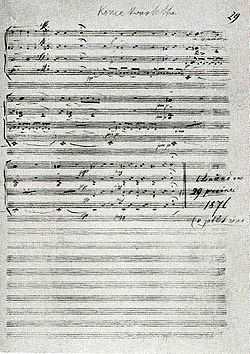String Quartet No. 1 (Smetana)

String Quartet No. 1 ("From My Life", Czech: "Z mého života") in E minor, written in 1876, is a four-movement Romantic chamber composition by Czech composer Bedřich Smetana.
Background
After becoming deaf, Smetana moved in 1876 from Prague to Jabkenice. He still hoped that the handicap would not be permanent. In the autumn of that year, he began to compose a new work. It was to be his intimate confession, a work depicting the course of his life, "... using four instruments speaking among themselves in something like a friendly circle".[1]
He completed the composition on 29 December 1876. In a letter to his friend Josef Srba, Smetana formulated the work's ideological conception and the features of the individual movements.
It was given a private premiere in 1878 in Prague, with Antonín Dvořák as violist,[2] and its public premiere took place on 29 March 1879, performed by Ferdinand Lachner, Jan Pelikán, Josef Krehan and Alois Neruda.[2]
The work is semi-autobiographical and consists of sketches of periods from Smetana's life, as is suggested by its subtitle Z mého života ("From My Life"). Its notable features include a prominent viola solo at the very beginning of the first movement, and a high, sustained harmonic E on the first violin in the last movement, which represents the ringing in his ears that presaged Smetana's deafness, although the actual ringing was a chord in A-flat major.
The work was published in 1880 by Fr. Urbánek in Prague.
Structure
The cycle consists of four movements:
- Allegro vivo appassionato
- Allegro moderato à la Polka
- Largo sostenuto
- Vivace
The first movement is an expression of the composer's romantic ideals in life and in his music. In the second movement the polka style recalls happy and convivial memories of his youth. The third movement is of great emotional depth, a paean to love, which transcends the adversities of fate and finds harmony in life. In the last movement the composer describes the journey that led to an understanding of the true essence of national art, only to be interrupted by the catastrophe of his incipient deafness. The end is almost resigned, with only a small ray of hope for a better future.[3]
Use in film
The dramatic opening of the first movement was featured in the 1992 film Sneakers at a concert which the characters attend. The viola soloist featured in the opening is Victoria Miskolczy, the associate principal viola in the Los Angeles Chamber Orchestra.
Footnotes
See also
References
- Bedřich Smetana: Quartetto I. Mi minore. Z mého života. Score. Prague: Editio Supraphon, 1991. S 7676. ISBN 80-7058-286-3